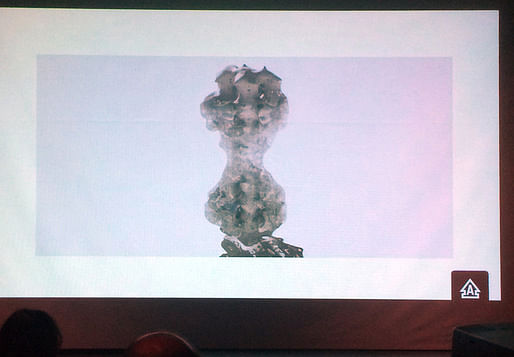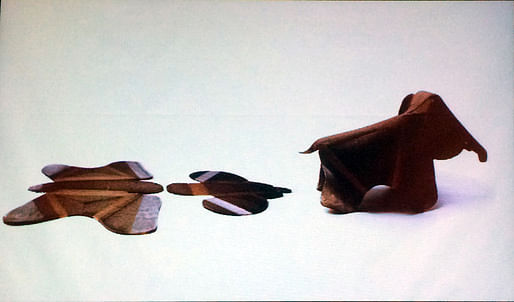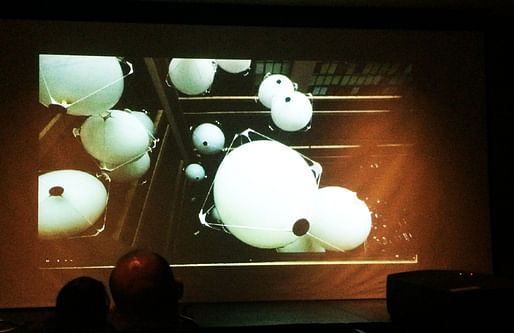
Day two of ACADIA 2014, which took place last Friday at the California Science Center across from USC's campus, brought a radical shift of focus and direction from day one. Materiality and Fabrication were on the forefront of thought and discussion. Ranging from robots making robots, or large robots that then became buildings, to computation executing technical drawings; everything in the built world was up for grabs.
A jump into our real world gave us a challenge, a glimpse of these introverted ideas and what they could culminate in. The goal was to discover, if even only slightly, how these tools in architecture could push the methods of production, reinvent them or combine them to find failures, successes or any combination thereof. Testing the limits of the digital with the reality of the analog world we inhabit.
All projects at some point returned to analog, all projects ripped themselves from their infinite processes and were born into mass and matter. Points from day one became full scaled people. Perspective renders of what could be, became photos of events, filled with light and smiles. There was no wondering what if. It was here.
There was something fresh in the air – to pull something out from the boundless reality impersonating 2d environment to our gravity and material filled world was exhilarating. With all the simulations, creations and ideas of a multi agent worlds, it came down to the physical nuts and bolts to find a rejuvenation of optimism in the crowd.

From Nazareth Ekmekjian's presentation. Photo by Anthony Morey.
Nazareth Ekmekjian (speaking on the panel, "From Surface to Volume - An Approach to Poche with Composites") took ideas, terms and thoughts tied closely to the foundation of architectural discourse such as poche, surface, extrusions and columns, and exploited them. He succeeded in making the digital messy by understanding where it failed. The project consisted of using burlap mixed with epoxy and eps foam to test our reading of thickness, edge and its misalignment with the digital’s inability to view those limitations or to inherently act upon them. His result is a completely analog production, one impossible to simulate.
His process model, beautifully leaking, spilling showed the humanity in the process. He succeeded, not in discovering a technique that is foolproof, but one that affirmed his initial concept – that the realm of computation and reality are not yet seamless.

From Skylar Tibbits' presentation, Eames' toy elephant experiment. Photo by Anthony Morey.
Skylar Tibbits (on the panel, "4D Printing and Universal Transformation"), with a continuation of his work from previous years such as the self-building protein that he presented at TED in 2013, proceeded to expand on this realm of time based materiality investigations. 4D printing is a process of creation where time (the forth dimension) plays a direct role in the objects. These objects are not static, but react and change through various external conditions.
His work focuses on self-assembly, and soon, disassembly. For example, in one project, by combining two 3D printed materials in one he could explode each materials properties such as stiffness, flexibility, temperature limits or weight. By understanding the qualities of each material separately, he was able to program the actions or character of each individual moment through the system.
His first project, a medley of floating balloons attached with magnets would float in an alley and repeatedly move up and down until connections were made, broken, remade and broken yet again. Through all the chaos, forms would become apparent. In the end, a perfect cube came into existence. A calm harmony of erratic behavior ending in a seemingly impossible equilibrium.

4D printing magnet and sphere experiment from Skylar Tibbits' presentation. Photo by Anthony Morey. “It is now possible to program nearly every material to assemble itself and transform in useful ways” - Skylar Tibbits.
This material programming application was shown in various scopes in production. Such as: new air flow flaps within airplanes that responds to exterior temperatures, allowing it to operate with no mechanical moving parts, thus keeping weight low and reducing wind drag. To the opposite side of the spectrum; a prototyped Eames Elephant toy that begins as a flattened surface and self-assembles to a three-dimensional object. The afternoon session changed gears and focused on fabrication – from robotic forming, and organizing all the way to construction drawing creation.
Adam Marcus (Centennial Chromograph: Data Spatialization and Computational Craft) presented his installation at the University of Minnesota School of Architecture, called "Centennial Chromograph". A full scale installation that was meant to interpret the life cycle of the architecture department for the last 100 years. Using computational design tools to generate formal and spatial constructions with large quantities of data, each year was grouped and codified. Using historical data to generate form, computation was used both for the creation of the surfaces and allocation of all the colored pencils. Each which was tied to a specific academic degree, person and year within the system. The process lead to an installation more closely resembling a DNA strand of the school than a timeline.

From Adam Marcus' presentation. Photo by Anthony Morey.
Here again, the materials used were low cost, high-effect. forcing computation to find ways to prove itself as worthy or furthering development. Thus, highly evolved, and advanced methods are interpreted with completely contradictory materials – the Analog. In this translation, all the projects discovered, and shined in their execution. They made it easy to compare, to understand and see potential. The reasons for development were clear, opportunities were obvious and creativity prospered.
Fabrication and Materials are at the end line of any architectural endeavor. From simple paper for drawings, all the way to pencils as structure, Acadia 2014 showed that with new tools come a reinterpretation of their and others' tools and that the past is open for reinvention or reeducation. Architecture can never escape these limits of the physical world. Not yet at least, but by trying and trying, one day we might remake that world.
See also: Anthony's reporting from Day 1 of ACADIA.
No Comments
Block this user
Are you sure you want to block this user and hide all related comments throughout the site?
Archinect
This is your first comment on Archinect. Your comment will be visible once approved.